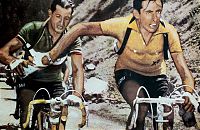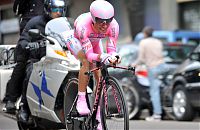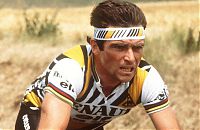Tom Simpson

Making history: Tom Simpson became the first British rider to wear the yellow jersey at the Tour de France after stage 12 in 1962 from Pau to St Gaudens.
Tom Simpson became the first British rider to win Paris-Nice in 1967, and was the only Brit to have done so until Bradley Wiggins’s victory in his golden season in 2012.
It was later in the 1967 season that Tommy Simpson died. He collapsed on the ascent of Mont Ventoux during stage 13 of the Tour de France and could not be resuscitated.
Rik Van Looy

Rik II one of the greatest one-day cyclists who won two world championships as well as eight “monument” classics, passed away on 17 December 2024. He was 90.
In a career that spanned a successful decade from the late 1950 onwards, he was the unchallenged No. 1 star in Belgium before he had to give way to the rise of Eddy Merckx, arguably the greatest cyclist of all time.
“He was a super champion. He was very demanding on himself, as he was on his teammates,” Mr. Merckx told VRT network. “Van Looy never showed any kind of weakness. He never cracked.”
Among the monument classics, he won Paris-Roubaix three times, the Ronde of Flanders twice and Milan San Remo, the Tour of Lombardy and Liege-Bastogne-Liege once. Winning the grand slam is especially tough in cycling since each classic demands specific qualities, be it sprinting, climbing or dealing with cobblestones.
Only two other riders completed the feat, fellow Belgians Merckx and Roger De Vlaeminck.
Mr. Van Looy’s world titles came in 1960 and 1961. And although he won 39 stages in Grand Tours, he never won the overall classification in either the Tour de France, the Giro of Italy or the Vuelta of Spain.
The federation said he won over 450 races in a career that began in 1953 and ended in 1970.
Source
Luigi Ganna: leggenda

Come una leggenda.
Ai giorni nostri ha dell’incredibile e dell’irreale il fatto che il giovane diciassettenne Luigi Ganna, tutte le mattine, si recasse in bicicletta da Induno Olona a Milano per fare il muratore, con una sacca fissata sul manubrio, con una pagnotta e una bottiglia d’acqua zuccherata allungata con un po’ di vino. Sole, pioggia o neve che fosse ogni giorno percorreva 100 km in bicicletta attraverso strade di terra battuta e un gran numero di buche. Luigi Ganna a questo suo impegno, alle energie consumate ogni giorno, dà un’altra valenza, usandolo come duro e serio allenamento per l’attività sportiva in bicicletta. Così nel 1905 Luison, detto anche il “gigante buono”, decide che la bicicletta sarà lo strumento con cui giocarsi il proprio avvenire. Sin dalle prime corse emerge il talento del giovane Ganna il quale si rivela ben presto l’uomo da battere in un ciclismo che sta diventando sempre più uno sport popolare. Consegue vittorie sin dal primo anno di attività agonistica, ogni anno che passa è una continua escalation fino alle grandi vittorie del 1909, anno in cui trionfa alla Milano – Sanremo e soprattutto al primo Giro d’Italia. Nello stesso anno grazie ai successi sportivi si compra la casa e una piccola officina. La diffusione delle sue biciclette avviene nel 1912 quando, con la vittoria alla Gran Fondo “La seicento chilometri” su una bicicletta di propria costruzione, si ha una delle più credibili presentazioni del nuovo prodotto. L’ascesa dell’azienda è rapida e in pochissimi anni l’officina diventa capannone e la produzione da artigianale industriale. Lavoratore instancabile dalla ferrea volontà, si impegna per offrire alle masse lavoratrici una bicicletta robusta, elegante e a basso prezzo. Nel 1914 lascia le corse per dedicarsi alla sua attività e successivamente alla costituzione della prima squadra “Ganna” ottenendo numerose vittorie tra le quali è doveroso ricordare la vittoria di Fiorenzo Magni del Giro d’Italia del 1951 in sella ad una bicicletta Ganna. Dopo la prima guerra mondiale l’azienda iniziò a costruire anche motocicli e Ganna divenne ben presto un marchio apprezzato in Italia e all’estero.
Negl’anni la tradizione non ha mai cessato di essere tramandata e oggi Ganna produce una gamma completa di biciclette con oltre 100 modelli suddivisi nelle linee city bike / trekking, hybrid, corsa, mountain bike, special bikes, junior ed ecobike che si contraddistinguono per il design ricercato, la qualità dei materiali e quella cura del dettaglio propri di un marchio che ha fatto storia.
Source: Retro-Ganna
» Read more











